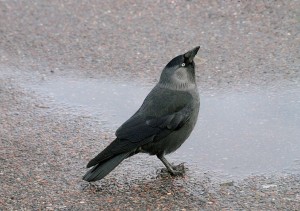 In the last two decades or more the revolution in making provisions for birds in gardens have taken many forms. Apart from feeding stations there are now a very wide range of nest boxes available and there are different designs for different species. In the larger sizes there are designs for tawny owls and kestrels. Open fronted nest boxes will be used by spotted flycatchers, robins and pied wagtails. Small nest boxes with holes in the side are used by great tits, blue tits and in some case even pied flycatchers. Then there are the trees and shrubs to plant that will give birds other aspects such as cover from predators such as cats and birds of prey. These also give shelter from rain and wind and are just as essential as other considerations.
In the last two decades or more the revolution in making provisions for birds in gardens have taken many forms. Apart from feeding stations there are now a very wide range of nest boxes available and there are different designs for different species. In the larger sizes there are designs for tawny owls and kestrels. Open fronted nest boxes will be used by spotted flycatchers, robins and pied wagtails. Small nest boxes with holes in the side are used by great tits, blue tits and in some case even pied flycatchers. Then there are the trees and shrubs to plant that will give birds other aspects such as cover from predators such as cats and birds of prey. These also give shelter from rain and wind and are just as essential as other considerations.Containers for water come in a wide variety of styles from simple dustbin tops in the ground to elaborate, and expensive, ornamental bird baths. Provision of water in very cold weather is not as easy as it seems. Ironically the birds do not seem to bother over designs as long as there is a few inches of water with sloping margins to give various depths for different sized birds. You may have to keep the water open for a few times each day in very cold conditions. There are additives specially designed for this that contain plant extracts to prevent the water freezing. Do not use other addictives as they could poison the birds. The photograph of a jackdaw was taken on the side of the harbour in Nairn and the bird is drinking from a puddle at the side of the road. Note that the head is extended upwards to get the water down its throat. Most birds do this but there is one exception, a bird that is common in gardens in and around Inverness . The wood pigeon has the ability to suck up the water so it does not need to throw its head back.
